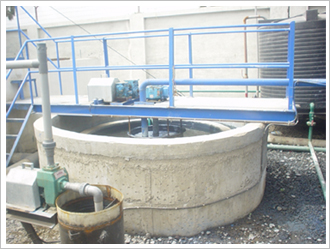

We are one of the leading manufacturers of high-quality Sewage Treatment Plants. Raw waste water is initially received into the anaerobic chamber, where most of the suspended solids settle down and undergo anaerobic digestion by the micro-organisms. The partially treated liquid then flows into the aerobic chamber, where freely dissolved oxygen is introduced. The oxygen enriched sewage comes into contact with micro-organisms, which then create stable oxidized products. These plants are easy to install and operate.
Features :
• No short-circuit
• Minimal sludge accumulation
• Easy to install
• Easy to operate
Raw waste water is initially received into the anaerobic chamber. Approximately 30 50% of the suspended solids settle out in this chamber where they undergo anaerobic digestion. The anaerobic digestion process is carried out by microorganisms which have the ability to feed, grow and multiply in the absence of free oxygen. In addition, settled sludge and skimmed material returned from the clarification chamber are further digested in this chamber. The plant is sized to enable these microorganisms to maintain a sufficient population naturally without the need for the addition of proprietary biological products.
The partially treated waste water, still containing the colloidal and dissolved solids which represent approximately 65% of the pollution loading, flows from the anaerobic chamber to the aerobic chamber. Air is introduced to the liquid in this chamber by means of a compressor and diffusers, maintaining aerobic (free dissolved oxygen) conditions. The oxygen enriched sewage flows about packs of submerged media having a large surface area on which bacteria and other microorganisms thrive, forming a biological film. These microorganisms have a different growth process to those in the anaerobic chamber in that they utilize the dissolved oxygen in the sewage, while consuming the dissolved and colloidal organic matter as food to create new cell growth and stable oxidized products. The air pattern causes the liquid in the chamber to pass through the media in a discreet flow pattern and to have intimate contact with the microorganisms.
The process differs from ordinary suspended growth systems in that it is more stable and also allows the growth of sub-surface anaerobic microorganisms beneath the surface film of aerobic microorganisms. This allows anaerobic bacterial action to check the media growth, thereby reducing the biological sludge accumulation. Nevertheless, as the thickening of material on the media occurs, some sloughing off will take place.
The multiple compartment design of the aerobic chamber ensures that no short-circuiting can occur, preventing the possibility of partially treated waste water passing to the clarification chamber. The diffused aeration system allows the air to be introduced below the media packs. Basically the reaction in the aerobic chamber converts the dissolved and non settle able (colloidal) solids into carbon dioxide and a biological, which, under quiescent conditions, will settle.